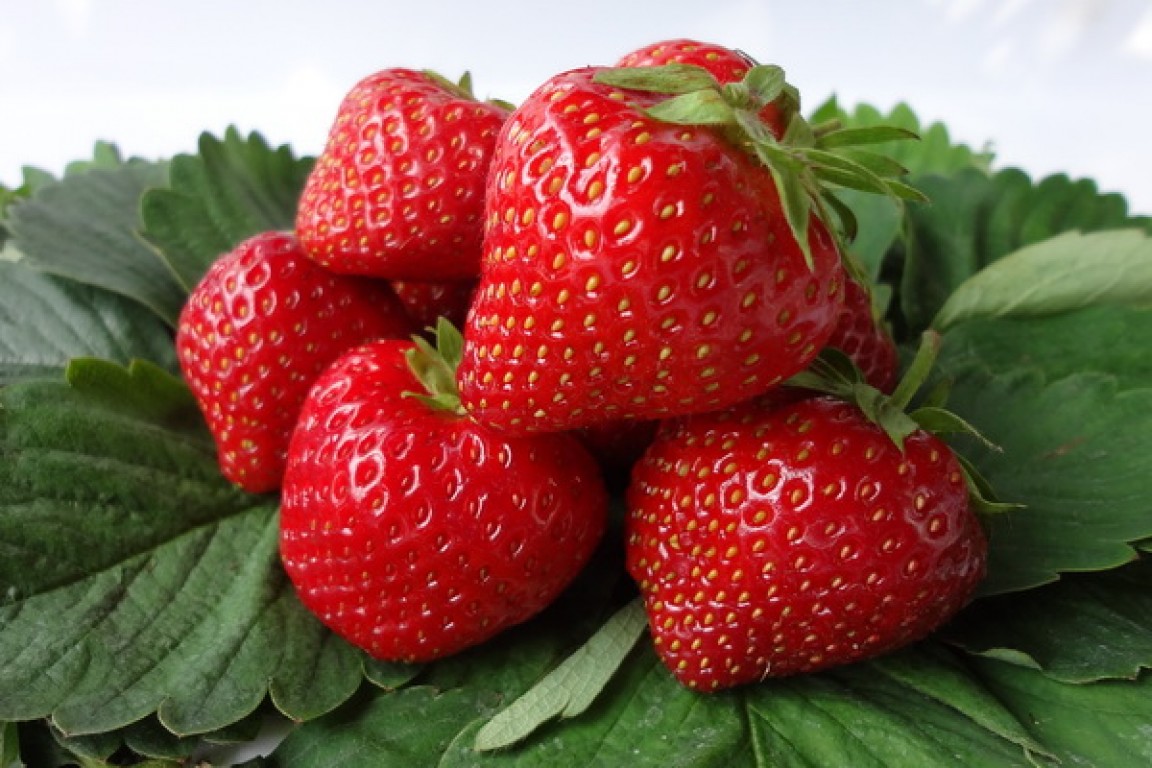Garden strawberries are one of the most common berry crops in horticulture, the assortment of which is replenished annually with new plants.
The special niche in it is occupied by the results of the work of Russian breeders, the best representative of which is the strawberry variety Tsaritsa. In a short time, the plant became popular with amateur gardeners and owners of strawberry plantations. In this article, we consider the description of the strawberry Queen, the rules of care and methods of pest control.
Table of contents
Breeding history
The author of the strawberry variety is Tsaritsa, Doctor of Agricultural Sciences S. D Aytzhanova, who since 1982 has headed the main breeding work on this crop in Russia. During this period, the genetic potential of more than 100 varieties and 8 species of strawberries was studied, the most valuable donors were identified, and a gene pool of starting material was created.
The main goal of the work of Russian breeders is to create frost-resistant and winter-hardy plants., increase of resistance to harmful microorganisms and improvement of the biochemical composition of fruits.
The strawberry variety Tsaritsa was created on the basis of the Red Gontlent varieties of the Scottish selection and Venta, the result of the work of Lithuanian breeders. These varieties are resistant to spotting, strawberry mite, winter hardiness and have large fruits with rich chemical composition. The main genetic characteristics of these varieties are combined in the strawberry Tsaritsa.
Characteristics and description of the variety
Strawberry Tsarina is a herbaceous perennial plant that grows up to 25 cm in height. In the second year after planting, the plant forms a beautiful bush with bright green leaves. Large white flowers are formed on strong stalks, not exceeding the height of the leaves.Mustache medium thickness, pubescent, red light.
Fruits of strawberry of the correct cone-shaped form, evenly maroon-red color with a glossy surface. The consistency of the pulp is dense and juicy, the taste is sweet with barely pronounced acidity. The average weight of the fruits of the first order is 30-50 g, the berries gradually become smaller, but not more than 15 g.
This is a variety of medium ripening. In the southern regions of horticultural berries begin to ripen in late May, and in the middle in the second half of June. Full compliance with agrotechnics plants allows you to collect an average yield of 2.5 kg per 1 m2.
The variety is zoned and recommended for cultivation in horticulture with a temperate continental climate, suitable for central Russia and more southern regions.
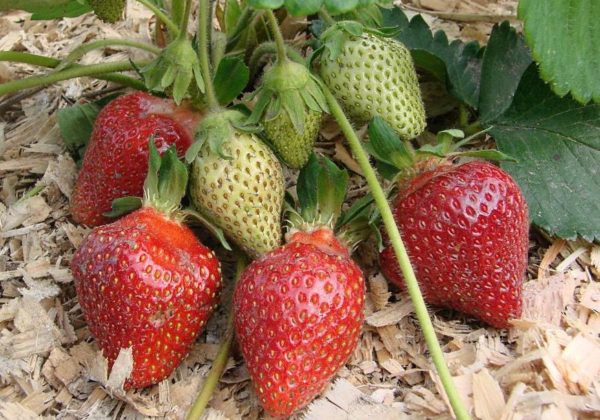
Benefits
Strawberries Tsaritsa is the real pride of the author, who gained popularity among gardeners. Crossing carefully selected varieties gave good frost resistance results.With proper preparation for winter and a sufficient level of snow cover, the plant is able to withstand temperatures down to –35 ° C – 40 ° C.
The plant is very resistant to late blight and fungal diseases. In recognition of many gardeners, strawberries are not affected even with the diseases of neighboring crops, maintaining the beautiful color of the leaves until the end of the season. Strawberries The queen is resistant to many pests, especially strawberry mites and slugs.
This is a drought resistant variety of strawberries. The plant is quickly restored after overheating and dehydration, without harming the future harvest. Therefore, it is ideal for planting in remote suburban areas, where it is possible a long absence of the gardener.
The sugar content is 9%, and the acid is only 0.9%. When fully ripe, fruits accumulate a record amount of vitamin C (60 mg / 100 g), potassium (161 mg / 100 g), iron (1.2 mg / 100 g), and many other beneficial elements for the body. Therefore, it is not only a tasty dessert berry, but also a useful source of nutrients.
Strawberry fruit well tolerated transportation and long-term storage. It is therefore excellent for large plantations where long periods of time are possible.
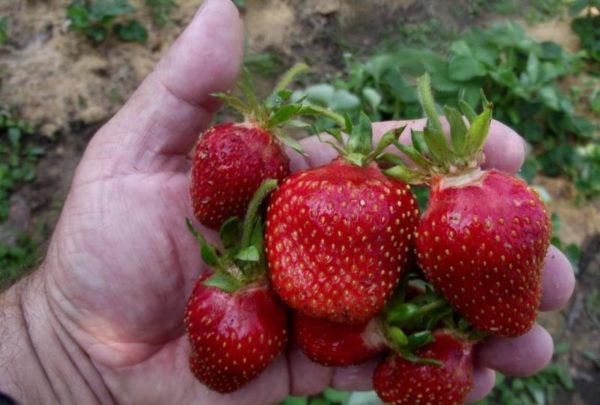
disadvantages
The main disadvantage of Tsaritsa strawberries is damage to the generative buds when the air temperature drops to -15 ° C. This occurs in the absence or low level of snow cover. This problem can be avoided by timely covering the plants.
The plant is often damaged by the wireworms and larvae of the Maybirds. Increased humidity and lower temperatures in summer can affect yield.
Planting seedlings of garden strawberries
The best time to purchase seedlings strawberries Tsaritsa - July. Planted immediately after purchase, the plants will have time to root well and lay flower buds, which will allow the next year to get a harvest.You can buy and plant seedlings in the spring, in this case it is better to choose plants with a closed root system. For quality assurance, planting material is purchased in nurseries or in reputable garden centers.
Seedlings quality indicators:
- at least 2-3 leaves, saturated green color;
- well developed apical bud;
- horn thickness not less than 0.7-0.8 cm;
- developed fibrous roots;
- length of the main roots of at least 7 cm;
- full development of the roots of the container (with the closed root system);
- lack of lethargy, spots and putrid lesions on the leaves and stems.
Acquired seedlings are wrapped in burlap and paper, protected from sunlight.
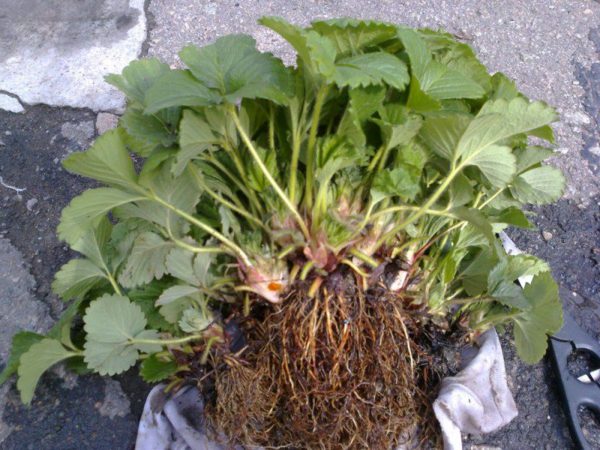
For planting strawberries choose flat areas or with a small slope (5 ° -8 °). The selected site should be protected from cold drafts, northern and eastern winds. Strawberries will develop poorly in the lowlands, where cold air often stagnates.
The best time for planting strawberries is spring (May 1-15), summer (July 20-August 10).To do this, pick up an overcast day or transfer the event to the evening when the sun's activity decreases.
The bed is prepared at least 15-20 days before planting. This is a digging to a depth of 25 cm, cleaning from the remnants of weeds and small stones.
During digging at the rate of 1 m2 contribute:
- rotted manure or compost 10 kg;
- superphosphate 10 g;
- potassium salt 50 g
For better absorption of minerals, the soil is watered. Strawberries react negatively to the liming of the soil, so it is permissible to bring it into the soil only in 2-3 years.
To fill the planting wells, a nutrient substrate is prepared. For this, humus (1 bucket) is mixed with superphosphate (30 g) and wood ash (500 g). In the prepared soil, dig holes with a depth of 30 cm and an average diameter of 20 cm, which are ¾ filled with the prepared substrate. The rest of the hole is supplemented with fertile soil and plentifully watered.. The recommended planting pattern is 30-50 cm between bushes and 40 cm between rows.
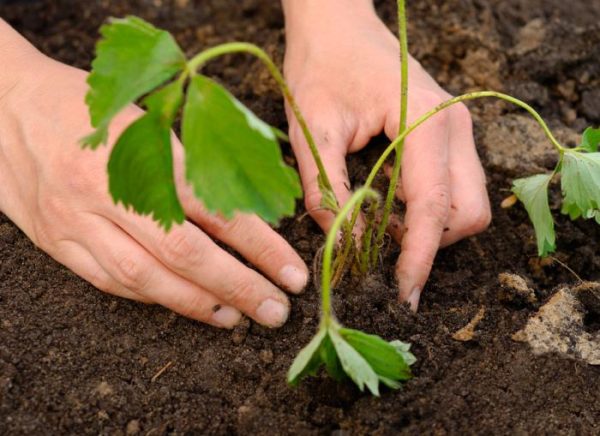
After absorbing moisture and settling the soil, you can start planting seedlings. For better rooting, they are treated with a growth stimulator — an aqueous solution of heteroauxin.To do this, 1 tablet of the drug is dissolved in 1.5 liters of water and immersed in the solution of seedlings to the level of the apical bud for 4 hours.
Seedlings of strawberries are planted without deepening the apical bud, spreading the roots along the perimeter of the hole. After sprinkling the roots and lightly compacting the substrate, the plants are watered with warm water (1 l / bush). If the seedlings are weak, it is permissible to plant two copies in one well.
In the absence of rain, seedlings are watered and sprayed for 4 days after planting. If the activity of the sun is large, young plants pritenyut sacking or raw grass for a week.
Strawberry Tsaritsa - skoroplodnoe plant, gardeners can enjoy the first berries in the same season when planting in the spring and next year when planting in the summer.

Caring for strawberries Tsarina
Strawberry Queen is very plastic culture, which is acutely responsive to all environmental changes.It feels bad when water stagnates, so in the spring, first of all, flood waters need to be removed from the ridge.
After the soil dries, the dried leaves that are sources of diseases and pests are removed from the surface of the bed. At the same time, the first loosening to a depth of no more than 2-3 cm under bushes and digging between the rows is carried out.
Further, before harvesting, loosening is carried out only with a strong compaction of the soil at a distance of no closer than 5-6 cm from the bushes. BDeeper and more intense loosening during this period can lead to damage to the finely spaced suction roots.
Subsequent deep loosening is carried out after harvest. In August and September, active root growth will begin, at this time weeding is carried out only with a strong compaction of the soil. During loosening, it is important not to allow the roots to be exposed, therefore the soil is slightly raked to the base of the bushes, but not spud. During the events, weeds are removed.
Under the condition of preplant soil fertilizer, strawberries are not fed in the first year. In subsequent years, strawberry fertilizer required. The first feeding is carried out in the spring, after cleaning the ridge of leaves. To do this, use urea (1 tsp.on 1 m2), the second before flowering - spraying the bushes with the Immunocytophyte water solution (2 g / 10 l).
The following dressing is carried out at the beginning of flowering, organic fertilizers. To do this, use an aqueous solution of mullein (1: 10) with the addition of wood ash (2 tbsp. L). Fertilizer is applied at the rate of 300 ml per shrub.
Another feeding strawberries needed during the laying of flower buds in the first decade of August. Fertilizer is carried out with mineral complexes containing phosphorus, potassium and nitrogen. The well-known preparation Ammofoska, which additionally contains sulfur, calcium and magnesium, is well suited for this. Fertilizer is made according to the recommended scheme.
Strawberry Queen will develop better with regular watering. There is no definite scheme for watering the plant. To determine the need for irrigation, you need to focus on the degree of soil moisture at a depth of 20-30 cm. Dry and crumbly soil signals the need for moisture. During the growth of the bushes, the average interval between irrigations is 7-10 days, while the berries are poured in for 5-6 days. The last watering is carried out in September or in early October, depending on precipitation.
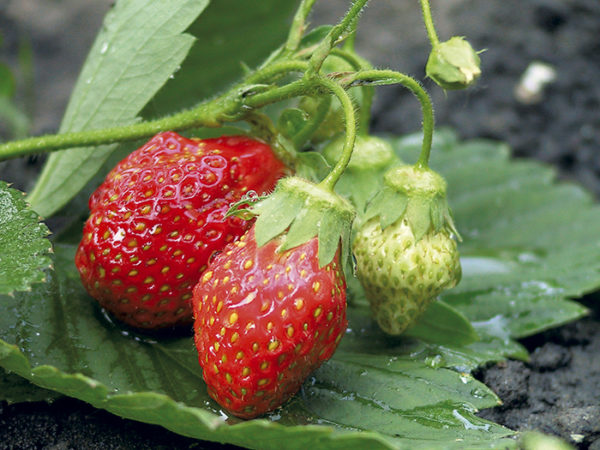
Another important event for the strawberry queen is the mustache trimming, which is carried out several times per season. The procedure is convenient to combine with the loosening of the ridge. Methods for removing whiskers depend on the landing pattern. In the case of bush planting, the whiskers are completely cut off with a sharp pruner to the outlet. In the line-by-line method of planting, cut off the whiskers that extend beyond the ridge, and the rest are guided along the row, slightly sprinkling with soil.
In the autumn, before the first frost, strawberries are prepared for winter. By bare roots tighten the soil, remove dried leaves and flower stalks. They renew the layer of mulch, increasing it to 5-7 cm. In regions with little snowy winters, the plant will be saved from frostbite by a layer of spruce branches or shelter with agrofabric. In winter, snow is pulled up to the ridge.
Despite the average yield, the amount of positive feedback from gardeners in the direction of strawberries Tsarina is growing every year.Basically, there is a high quality of the pulp and aesthetics of the appearance of the fruit, the absence of disease and the stability of yield. A small plot with strawberries is enough to provide the family with healthy berries all year round.
